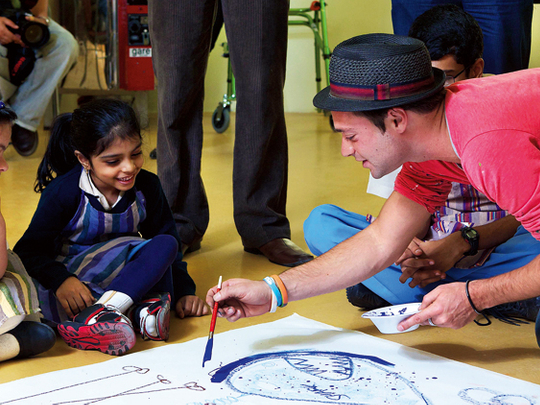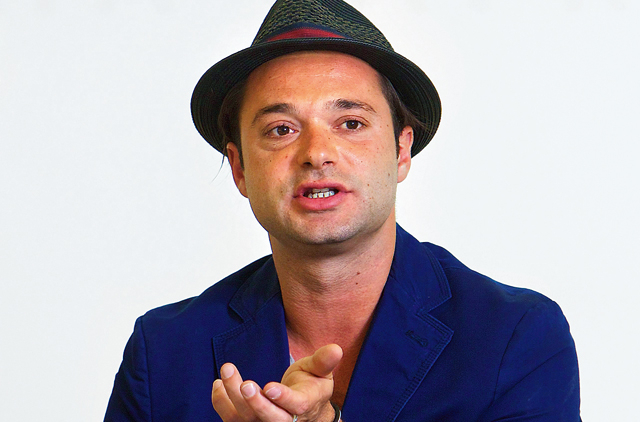
A list of his admirers reads like a catalogue of the world's most rich and famous. From American President Barack Obama to Microsoft's Bill Gates, F1's Bernie Ecclestone, music legend Madonna, Hollywood stars Leonardo DiCaprio and Sir Ben Kingsley, and even the UAE royal families, it's fair to say that artist Sacha Jafri has a few influential fans. But, while his paintings typically sell for between $250,000 (Dh900,000) and $750,000 (Dh2.8 million), he values money only to the extent that it enables him to continue to paint and devotes his spare time to making a difference to others, especially children.
Having personally raised over $14 million for charities around the globe from the sale of his art, Iranian/Indian Sacha has been recognised by the United Nations with an award for his artistic and humanitarian accomplishments.
He'll be continuing his good work during his visit to Dubai on March 18, when he will collaborate with Al Noor Training Centre for Children with Special Needs and UAE-based business house Majid Al Futtaim to create a piece of art celebrating the lives of special needs children. A workshop with 20 Al Noor students at the Gate Village in DIFC will aim to make a "unique representation of the past, present, and future visions of the students". The finished piece will then be auctioned to raise money for the children - hopefully at least Dh1 million, which isn't far-fetched considering Sacha's David Beckham painting featuring the sport star's footprint on canvas scored Dh1.8 million at a charity auction in 2009.
Seeing the bigger picture
Although Sacha is the youngest living artist for whom a ten-year retrospective has been held (in 2008) - he was 31 at the time - he doesn't consider that a major achievement. "I don't really think about that," he says. "For me, art is about more than creating things for people to look at. It's about something more powerful, it's about understanding humanity and humility. For me, it's about the work of people like Mahatma Gandhi and Nelson Mandela."
Sacha says he concentrates on his journey as an artist, working with impoverished children and those who have been affected by war. "By working with them I am doing something worthwhile, and then my work comes out of that," he explains. "I think it adds some magic to it, something special, something that no one else can copy."
Sacha's painting is not only deeply rooted in his concern for humanity, but also in fulfilling a need within himself.
"I've never done a painting, sold it and forgotten all about it," he says. "I am not in this world to do that. I've given my life to painting, and if you've dedicated your life to anything, you do it properly, you don't mess around. You become the greatest and you leave a legacy to the world. To do that you have to live it, breathe it and just get into your work so much that the thing you create is never forgotten. That's my philosophy," he says.
He is certainly well on his way to achieving this ambition: in recognition of his many achievements, the 21st Century Leaders Foundation, a charity that leverages the influence of well-known figures to promote positive change for humanitarian and environmental issues, invited Sacha to become a 21st Century Leader. This puts him in the company of many other luminaries who will not soon be forgotten, including Sir Bob Geldof, Archbishop Desmond Tutu, Dame Vivienne Westwood, Sir Roger Moore, George Clooney and Sir Paul McCartney.
Not painting by numbers
With the staggering figures his works can garner, the Financial Times and New York Times have described buying Sacha's work as a shrewd investment. "I don't complain about that," he laughs. "It's a nice thing, but it doesn't sit with me at all. It has to do with the press who focus on two sides of art - one on the financial side and the other on the more ethereal, spiritual side of art. And they're both important to send the message out."
However, Sacha says money is not really important in his scheme of things. Based in London and New York with his wife, Lucy, and daughter, Talia Love, Sacha doesn't own many of the trappings of wealth that you might expect from someone whose creations can raise millions. "I don't have any fancy cars, shoes or suits, or a fancy house that costs me loads of money to maintain," he says. "Money becomes a lot less important when you don't go in for such things. Rather, money is about enabling me to buy time," he explains. "It takes me two years to do a collection, and usually my collections are no more than 12 pieces. So, they invariably sell out. Then I take off, travel to around eight or nine different countries, because I want as many people as possible to see them. The money that I make from that gives me the next two years to paint."
A successful artist who's not interested in money is a paradox in this age, and Sacha is aware of it. "Unfortunately, there's a lot of nonsense in the art world, a load of rubbish. If you are well-educated and reasonably intelligent, you see it for what it is. You see the rubbish that people talk about art and galleries and all that. I don't want to be part of that."
Having had a very privileged upbringing himself, educated at the British boarding school Eton and at Oxford University, Sacha is determined to maintain his sense of perspective. "My background is what gives me the insight into all this," he says. "If I am going to dedicate my life to art I don't want to be part of anything I don't believe in."
Dedicated to his art
Sacha believes his all-or-nothing commitment to painting sets him apart from his peers.
"Whether consciously or subconsciously, I decided that I was going to live and breathe art. There aren't many true artists out there any more. Fifty years or a hundred years ago, people lived and breathed their art, that's what they did all day, every day, that was what was in their heart. Today art has become a commodity. It's about producing something, marketing it, and selling it. I don't want to be like that. I want to paint, believe in what I do, and live it. Out of that comes this understanding of humanity."
Literature also informs Sacha's art. "My inspirations come from humanitarians like Gandhi, Mandela and writers like Khalil Gibran, Rohinton Mistry, Paulo Coehlo, Franz Kafka... I read and absorb everything around me, and go on a journey as an artist... These things evolve and then you make something different."
His creative process is very organic. "I don't turn on and off, I paint from the subconscious - meaning I spend my conscious time absorbing everything," he says. "I fill my conscious time with interesting things. I write poetry, listen to music, interact with people, no matter who they are, travel, absorb everything. Then I take it all to my work. When I bring all that back from my subconscious to the conscious, it moves from my mind to my arms, and hands, it flows without the intervention of the mind. I have no idea what will eventually turn up on the canvas. I am usually surprised at what I create, and that's why I like my work! I don't feel that I've created it."
Young at heart
Sacha thinks there aren't many artists who are interested in children, and he finds that very strange. "The world is about our children, and I find it weird that artists who are meant to be reflecting the world don't have the understanding of the importance of children," he says. "I guess it's because I am still a child within. So, the reason I have this affinity for children is because I am still a child. I've always been more inspired by children than by adults. I meet a three-year-old and see something in his or her spirit that inspires me."
This is where his work with the Al Noor students comes in. "I work with children because I love to. It inspires me and hopefully it gives back something to them," he says. "I travel around the world doing workshops with them. I only work with special needs children or children in extreme poverty or children who've suffered war, in places like Africa, Syria, Palestine, Iraq, Eastern Europe and Sierra Leone, among others."
His technique is to work with the children for six to eight hours a day, slowly building a relationship with them, and in turn getting something special from them - an indefinable experience that fuels his artistic fire. "I don't show those paintings, that's not my work or art," says Sacha. "I do that as an exercise, like cricket; just as a cricketer spends his time in the nets training, I work with children then go to my studio and create my work from the experiences I've had with children. Hopefully it's a bit more special. That's the idea.''
Staying in the frame
Sacha's ultimate goal is to "create art that will be remembered after I am dead, that lives on after me. I want to be remembered in the history of art as an important, poignant artist.
"When I went to Oxford I remember on the first day the teachers give you a list and say ‘go and look at these artists, go to the library and get these books…'. I want to be one of those artists! That's my ambition. The names the media knows, and therefore the public know, are not necessarily the names that will live as legacy. The names that will be remembered will be Picasso, Leonardo Da Vinci, Michaelangelo, Degas, Van Gogh, among others. But the message of a lot of contemporary artists who are around today will not live on forever. It's not something you can put your hands on, you can't really say why. That's something I aspire to."
But he wants to improve the world at the same time. "Part of my journey is to work with charitable entities," he says. "If you want to understand humanity you've got to work with charities around the world."
Art for Sacha is a way of life. "It's certainly not a job. You can't see being an artist as a job, or a career. A lot of young people, especially in this region, seem to think so. It's impossible.
"Generally, very few artists will make it, and if they think of it as a career, less than one per cent will make it."













